2. Nation-wide investigations of artificial reefs and sloping dykes
(1) Purpose
The revised Seacoast Law enforced in 2000 stipulates that the purpose of coastal conservation is to achieve a harmonious balance among protection, the environment, and usage, and so consideration of the environment and usage has become increasingly important when constructing coastal conservation facilities.
Major criticisms of coastal conservation facilities in regard to the environment and usage include deterioration of the landscape due to detached breakwaters and impeded access to beaches caused by upright dykes and wave-absorbing works. To counter these problems, substituting facilities are either installed or planned, i.e., artificial reefs to replace the former and gently sloping dykes (including revetments) to replace the latter.
Nevertheless, methods of designing artificial reefs and gently sloping dykes were developed only two decades ago, and there have been cases of damage and disputes on the scope of adopting the design methods when proceeding with construction. Presently, greater objectivity is required for civil engineering structures and performance requirements in the technological standards, to enable more reasonable planning and designing. Thus, the performances of artificial reefs and gently sloping dykes need to be clarified.
Accordingly, to identify the future direction for research, revision of standards, and development of structures, the Seacoast Office, River Bureau, MLIT, implemented a nation-wide questionnaire in fiscal 2001 regarding artificial reefs and sloping dykes which were either completed or being constructed within the past five years by the coastal construction works under the jurisdiction of the River Bureau, and collected the dimensions of 130 artificial reefs and 138 sloping dykes.
(2) Results of the questionnaire
1) Artificial reefs
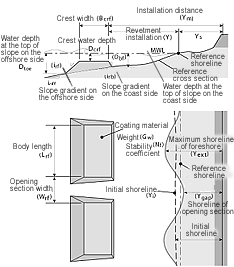
Definition of artificial reef dimensions |
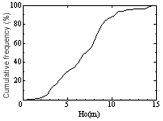
Target offshore wave height of artificial reef |
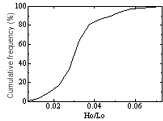
Target waveform gradient of artificial reef |
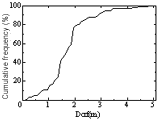
Water depth of the artificial reef crest |
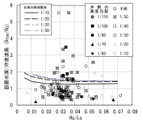
Positions of artificial reef installation and wave breaking |
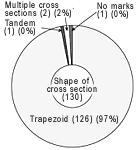
|
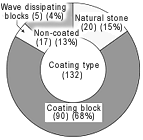
|
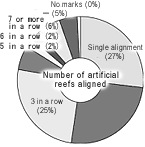
|
|
Configuration of artificial reefs
|
Coating materials of artificial reef crest
|
Number of artificial reefs installed
|
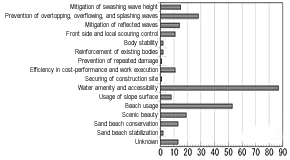
|
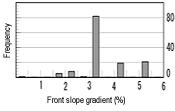
|
2) Sloping dykes
|
Reason for selecting sloping dykes
|
Front slope gradient of sloping dykes
|
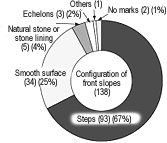
|
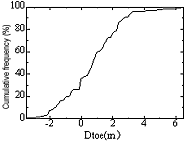
|
|
Front slope type of sloping dykes
|
Elevation of the slope toe of sloping dykes
|
(3) Conclusions
The questionnaire results revealed the following.
1) In many cases, artificial reefs are installed as continuous levees of a trapezoidal shape with the crest covered with blocks at a crest water depth of 1 to 2 m inside the breaking water zone with equivalent deepwater wave height of 7 m and wave steepness of 0.02 to 0.04.
2) Considering the position of installation, the effect of the wave-absorbing function of artificial reefs is mainly due to the dissipation of energy when waves overtop the crest after breaking.
3) Utilization of stone materials and existing wave dissipating concrete blocks and improvement of the cross section to raise efficiency, which are important for making artificial reefs more harmonious with the environment, have not progressed.
4) Many sloping dykes are step-type dykes with 30% gradient on the front slope, and most of those completed or being constructed recently are designed to allow access to the beach.
5) In many cases the toe of the slope of gently sloping dykes is installed near the shoreline. As both environmental and usage considerations are important, the width of sand beach to be left available needs to be considered carefully when building gently sloping dykes.
